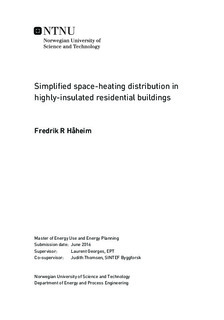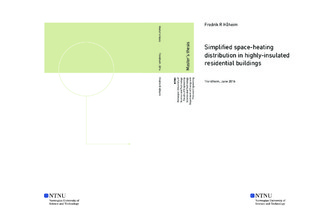| dc.description.abstract | With the world facing climate changes there is a need for drastically reducing the energy consumption. In the building sector this can be effectively done be introducing super-insulated buildings, such as passive houses, in cold climate countries. The super-insulated building envelope enables for introducing a simplified space heating distribution system, with few heat emitters. This Master s thesis investigates the trade-off between thermal comfort and energy efficiency in two Norwegian row houses with a simplified hydronic heating distribution system, built according to the Norwegian passive house standard.
It was performed temperature measurements during two separate two-week periods in March and April in the dwellings, along with detailed user interviews. The thermal comfort and energy efficiency was investigated using detailed dynamic building simulations (IDA-ICE).
The calibration of the IDA ICE-model with the measurements reproduced satisfactory temperature levels in most rooms, although not perfect. It was performed yearly simulations with different control strategies to lower the bedroom temperature to a satisfactory level. Control strategies with window openings was able to introduce the lowest bedroom temperatures. Without door and window openings, supplying air with 16 ℃ appeared to be the best solution if the bedroom temperature wanted by the occupants is 14-16 ℃. This strategy resulted in a heating demand of 37.7 kWh/m2year with space-heating set point of 21 ℃. However, this strategy could possibly cause discomfort with the living room temperature mostly between 20-22 ℃, compared to the desired temperature of 22-23 ℃. If desired bedroom and living room temperature is 20 ℃ and 22 ℃ respectively, supplying air with 21 ℃ appeared the most suitable option, with a resulting heating demand of 34.1 kWh/m2year.
Based on the building simulations performed and with the given conditions, it might be difficult to introduce substantial temperature zoning within this kind of building typology. If desiring 14-16 ℃ in the bedroom and 22-23 ℃ in the living room, occupants would have to enter some kind of compromise, and accept deviations from their desired temperature level.
The possibilities for introducing such drastic temperature zoning inside dwellings with large temperature differences (5-10 ℃) between rooms, should be investigated further. | |

